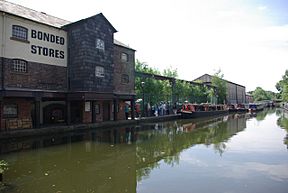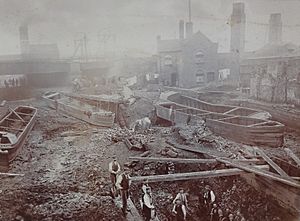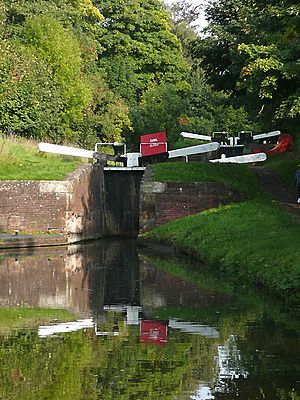Stourbridge Canal facts for kids
Quick facts for kids Stourbridge Canal |
|
|---|---|

The terminus of the Stourbridge Town arm of the canal
|
|
| Specifications | |
| Length | 5.25 miles (8.45 km) |
| Maximum boat length | 70 ft 0 in (21.34 m) |
| Maximum boat beam | 7 ft 0 in (2.13 m) |
| Locks | 20 |
| Status | Open |
| Navigation authority | Canal and River Trust |
| History | |
| Original owner | Stourbridge Canal Company |
| Principal engineer | Thomas Dadford |
| Date of act | 2 April 1776 |
| Date of first use | 1779 |
| Geography | |
| Start point | Brierley Hill |
| End point | Stourton, Staffordshire |
| Connects to | Staffs & Worcs Canal, Dudley Canal |
The Stourbridge Canal is a waterway in the West Midlands of England. It connects the Staffordshire and Worcestershire Canal at Stourton with the Dudley Canal. This link helps boats travel to Birmingham and the Black Country using the Birmingham Canal Navigations. Canals like this were once like busy highways for moving goods.
Contents
Building the Stourbridge Canal
The idea for the Stourbridge and Dudley canals started in 1775. The main goal was to move coal from Dudley to Stourbridge. A survey was done, and people agreed to pay for the project. A powerful person named Lord Dudley was a big supporter.
However, other canal companies in Birmingham were against the plan. They worried about losing business. Despite this, two separate plans for the Stourbridge and Dudley canals became laws on April 2, 1776.
Early Construction and Costs
The law allowed the canal builders to raise £30,000. Thomas Dadford was chosen as the main engineer. Work began on a special bridge, called an aqueduct, to carry the canal over the River Stour.
By 1778, all the money had been spent. Even though they weren't supposed to, the company borrowed more money to finish the work. Most of the canal was ready by 1779, and boats started using it. The whole canal was likely open by December of that year.
In 1782, a new law allowed the company to raise another £10,000. This also made the earlier loans legal. The total cost to build the canal was about £43,000.
Connecting to Other Canals
The Stourbridge Canal Company wanted to make it easier to move coal. They tried to connect their canal to the Birmingham Canals in 1784. This led to the building of the Dudley Tunnel, which opened in 1792.
They also tried to build a longer canal to the River Severn. This plan would have needed many locks and tunnels. But it was stopped in 1786 by the Staffordshire and Worcestershire company. However, two years later, that company lowered their fees for coal from Stourbridge.
Busy Trade on the Canal
The canal became very busy. It carried coal, ironstone, and limestone. It also moved iron products, bricks, clay, pottery, and glass. The canal company started making a profit. By 1789, they were paying out 6.3 percent of their earnings to investors.
How the Canal Was Used
Trade on the Stourbridge Canal kept growing. By 1796, over 100,000 tons of goods were moved. The canal became an important route, especially after the Dudley Tunnel opened. Profits for the canal company continued to rise.
Keeping Up with Demand
To handle all the traffic, the Stourbridge basin, a wide area for boats, had to be made bigger in 1807. More trade came after 1815 when the Worcester and Birmingham Canal opened. Iron from Coalbrookdale was sent to London using this canal route.
In the 1820s, new loading areas called wharves were built. These helped serve the growing coal mines near Kingswinford. The canal company even thought about building more lines in that area.
Life for the canal workers also changed. Lockkeepers, who operate the canal locks, started getting paid more. This was because the locks were being used all night and on Sundays. In 1836, over 144,000 tons of coal were carried on the canal, plus many other goods.
The Arrival of Railways
In 1844, a new railway line was planned. It would run next to both the Stourbridge and Dudley canals. Even though the canal company was against it, the railway opened in 1852 and 1853.
At first, the railway didn't have a huge impact. But eventually, some goods started moving from the canal to the trains. This led to agreements on fees for transferring goods. A special railway siding was built at Stourbridge wharf in 1858.
The canal still had good business from local industries. These included ironworks, a tinplate factory, coal mines, brick makers, and glassworks. However, the canal's income slowly began to drop. By 1873, profits were less than 8 percent.
Decline and End of Commercial Use
New laws in 1888 actually helped the Stourbridge Canal's income for a short time. They made it easier to charge fees. The company also kept dredging and improving the canal. This helped local trade continue.
But then, road vehicles became a big competitor. In 1929, the canal still made £3,750 from fees. But by 1938, the profit was only £222. By 1946, fees were down to £1,278. Commercial use of the canal kept going down until it stopped completely.
The Stourbridge Extension Canal
A separate company built the Stourbridge Extension Canal. It connected to the Fens Branch and went to Shut End in Kingswinford. This opened up more coal mining areas. This extension canal was used until after the Second World War. Most of it was then filled in, but a small part remains for boats to moor.
1903 Canal Collapse
On November 14, 1903, a part of the canal bank and bottom fell into old mine workings. This happened near Brettell Lane bridge. A three-mile section of the canal lost all its water. The water flooded nearby factories and caused a lot of the ground to sink. An 18-foot boiler even disappeared into one hole!
Luckily, this happened on a Saturday afternoon when workers were not there. Otherwise, many lives could have been lost. The mines and factories were shut down for a while. They needed the canal water for their machines and to move materials.
The Canal's Path
The Stourbridge Canal starts at Stourton Junction, connecting to the Staffordshire and Worcestershire Canal. Right away, boats go through four locks to climb higher. After these locks, there's a long stretch of canal that crosses the River Stour on an aqueduct.
At Wordsley Junction, the canal splits. The Stourbridge Arm goes into the town of Stourbridge. The main canal continues uphill through sixteen locks. These locks lead towards Pensnett Chase, where coal mines used to be.
From the top lock, the canal continues for about 1.8 miles to Delph Locks. These locks are the start of the Dudley Canal. Originally, there were nine locks here, but they were rebuilt as eight in 1858.
The Stourbridge Canal is part of the Stourport Ring. This is a popular route for people who enjoy boating for fun. The whole route is 74 miles long and goes through 105 locks on six different waterways.
Stourbridge Town Arm
The Stourbridge Town Arm branches off at Wordsley Junction. It goes into the town of Stourbridge. In the 1850s, a railway line was built to connect to the Stourbridge Basin. This basin was a place where goods could be moved between trains and canal boats. This helped the canal stay in use for longer.
Bringing the Canal Back to Life
By the 1950s, many canals were no longer used for trade. In 1959, a group called the Inland Waterways Protection Society suggested restoring the Stourbridge and Dudley Canals. The Inland Waterways Association also started working to save the canal. This was especially important after the Stourbridge locks were closed in 1960 for bridge repairs.
Volunteer Efforts and Rallies
To help their cause, the Inland Waterways Association and the Staffs and Worcs Canal Society organized a big boat rally in Stourbridge in 1962. British Waterways, the canal authority, put up signs saying the locks couldn't be used. A part of the Stourbridge arm was also blocked by mud.
When British Waterways didn't clear the mud, volunteers did it themselves! They used a special digging machine they borrowed. This created a lot of news and publicity. Many boats came for the rally, and local authorities supported the idea of bringing the canal back.
A Test Case for Restoration
In 1964, British Waterways said that keeping the Stourbridge Canal was "borderline." But they also said that if people showed real support, it could change things. The Staffordshire and Worcestershire Canal Society (S&WCS) suggested a plan. Volunteers would do the hard work, and British Waterways would provide materials.
A new law in 1962 allowed canals to be valued for fun and recreation, not just for business. Because of this, British Waterways accepted the S&WCS plan as a test. Restoration work began in 1964.
Volunteers worked on the canal during weekends. Groups like the S&WCS, the Dudley Tunnel Society, and the Coventry Canal Society all helped. Newsletters were created to tell people what was happening. This helped more volunteers join in. In 1967, a record 45 people worked on the canal in one weekend! The canal was fully opened for boats again in May 1967. This success led British Waterways to accept similar volunteer projects on other canals.
2008 Canal Breach
On September 7, 2008, a large part of the canal bank collapsed during flooding of the River Stour. This happened between Bellsmill and Stourton Locks. The water completely drained from the canal, including the Stourbridge Town Arm. The flooding of the River Stour caused water levels in the canal to surge.
British Waterways quickly repaired the canal. They reopened it on December 18, 2008. The repairs cost £650,000. They even built a large concrete block to make the bank stable again.



